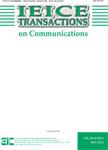版权所有:内蒙古大学图书馆 技术提供:维普资讯• 智图
内蒙古自治区呼和浩特市赛罕区大学西街235号 邮编: 010021

作者机构:Nagoya Inst Technol Grad Sch Engn Dept Comp Sci & Engn Nagoya Aichi 4668555 Japan Panasonic Corp Digital & AI Technol Ctr Technol Div Yokohama Kanagawa 2248539 Japan
出 版 物:《IEICE TRANSACTIONS ON COMMUNICATIONS》 (IEICE Trans Commun)
年 卷 期:2022年第E105B卷第8期
页 面:931-943页
核心收录:
学科分类:0810[工学-信息与通信工程] 0808[工学-电气工程] 0809[工学-电子科学与技术(可授工学、理学学位)] 08[工学]
基 金:Grants-in-Aid for Scientific Research [22K04102] Funding Source: KAKEN
主 题:radio-wave encryption chaos modulation physical layer security LLR clipping multiple-input multiple-output
摘 要:In recent years, there has been significant interest in information-theoretic security techniques that encrypt physical layer signals. We have proposed chaos modulation, which has both physical layer security and channel coding gain, as one such technique. In the chaos modulation method, the channel coding gain can be increased using a turbo mechanism that exchanges the log-likelihood ratio (LLR) with an external concatenated code using the max-log approximation. However, chaos modulation, which is a type of Gaussian modulation, does not use fixed mapping, and the distance between signal points is not constant;therefore, the accuracy of the max-log approximated LLR degrades under poor channel conditions. As a result, conventional methods suffer from performance degradation owing to error propagation in turbo decoding. Therefore, in this paper, we propose a new LLR clipping method that can be optimally applied to chaos modulation by limiting the confidence level of LLR and suppressing error propagation. For effective clipping on chaos modulation that does not have fixed mappings, the average confidence value is obtained from the extrinsic LLR calculated from the demodulator and decoder, and clipping is performed based on this value, either in the demodulator or the decoder. Numerical results indicated that the proposed method achieves the same performance as the one using the exact LLR, which requires complicated calculations. Furthermore, the security feature of the proposed system is evaluated, and we observe that sufficient security is provided.